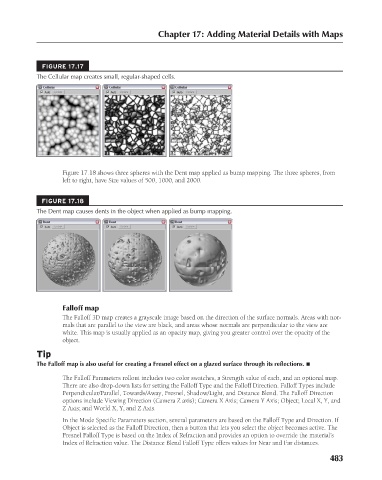Page 531 - Kitab3DsMax
P. 531
Chapter 17: Adding Material Details with Maps
FIGURE 17.17
The Cellular map creates small, regular-shaped cells.
Figure 17.18 shows three spheres with the Dent map applied as bump mapping. The three spheres, from
left to right, have Size values of 500, 1000, and 2000.
FIGURE 17.18
The Dent map causes dents in the object when applied as bump mapping.
Falloff map
The Falloff 3D map creates a grayscale image based on the direction of the surface normals. Areas with nor-
mals that are parallel to the view are black, and areas whose normals are perpendicular to the view are
white. This map is usually applied as an opacity map, giving you greater control over the opacity of the
object.
Tip
The Falloff map is also useful for creating a Fresnel effect on a glazed surface through its reflections. n
The Falloff Parameters rollout includes two color swatches, a Strength value of each, and an optional map.
There are also drop-down lists for setting the Falloff Type and the Falloff Direction. Falloff Types include
Perpendicular/Parallel, Towards/Away, Fresnel, Shadow/Light, and Distance Blend. The Falloff Direction
options include Viewing Direction (Camera Z axis); Camera X Axis; Camera Y Axis; Object; Local X, Y, and
Z Axis; and World X, Y, and Z Axis.
In the Mode Specific Parameters section, several parameters are based on the Falloff Type and Direction. If
Object is selected as the Falloff Direction, then a button that lets you select the object becomes active. The
Fresnel Falloff Type is based on the Index of Refraction and provides an option to override the material’s
Index of Refraction value. The Distance Blend Falloff Type offers values for Near and Far distances.
483
6/30/10 4:25 PM
25_617779-ch17.indd 483
25_617779-ch17.indd 483 6/30/10 4:25 PM

